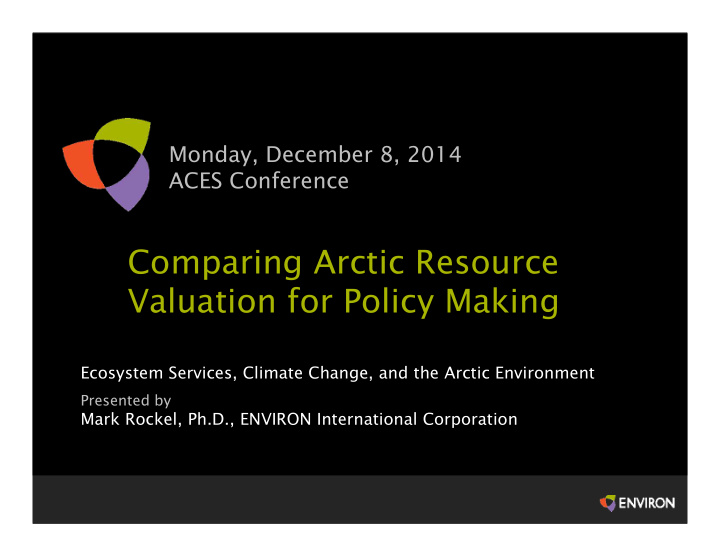



Monday, December 8, 2014 ACES Conference Comparing Arctic Resource Valuation for Policy Making Ecosystem Services, Climate Change, and the Arctic Environment Presented by Mark Rockel, Ph.D., ENVIRON International Corporation
Introduction • Working Backwards: Which Policies? • Which Ecosystem Services? • Valuation Fundamentals • Summary
Working Backwards: Which Policies?
Working Backwards: Which Policies? • Policies Related to Climate Change – Mitigating Impacts – Adaptation – Monitoring • Policies Related to Biodiversity – Overexploitation – Invasive Species – Preservation of Habitat – Resiliency
Working Backwards: Which Policies? • Policies Related to Development – Oil and Gas Development – Other Mineral Development – Increased Shipping Lanes – Indigenous and Coastal Populations
Working Backwards: Which Policies? Mitigation; Adaptation; Oil and gas; Monitoring transportation; Development indigenous and Climate Change coastal populations Biodiversity Preservation of Habitat; Invasive Species; Exploitation All of the Above
Which Ecosystem Services?
Which Ecosystem Services? • Provisioning – Reindeer – Commercial Fisheries (10% of Global; 5.3% of Global Crustaceans by weight) – Commercial and Subsistence Hunting, gathering, and small –scale fishing – Recreational and Sport Hunting From Arctic Biodiversity Assessment, Conservation of Arctic Flora and Fauna (CAFF)
Which Ecosystem Services? • Cultural – Tourism – Non-Market Values From Arctic Biodiversity Assessment, Conservation of Arctic Flora and Fauna (CAFF)
Which Ecosystem Services? • Supporting and Regulating – “Other services, including supporting services that make possible other ecosystem functions, and regulating services, that keep ecosystems in balance, are not considered here. They are important, but relatively little information is available for the Arctic on these topics” From Arctic Biodiversity Assessment, Conservation of Arctic Flora and Fauna (CAFF), a working group of the Arctic Council 2013 , 678 pages !
Which Ecosystem Services? • Supporting – More than 50 percent of the world’s wetlands – Arctic and Antarctic together account for more than 10 percent of global freshwater reserves
Which Ecosystem Services? • Regulating – Temperatures – Sea level – Jet Stream
Valuation Fundamentals
Valuation Fundamentals • What is the policy question? • Which ecosystem service(s) are needed? • Do you need monetary units or are ecological units sufficient? • Select boundaries of analysis: – Geographic – Demographic – Temporal
Valuation Fundamentals • Estimate the Baseline, not the Stock – Measure an indicator – Something quantifiable – Through time – Much Climate Change Work Focuses on the Difference between Current Conditions and the Future under Climate Change Baseline = Current Conditions – Policy Choices often need a Baseline that Includes Climate Change Baseline = Future under Climate Change
Valuation Fundamentals • More on Baseline – Baseline should capture climate change impacts – IPCC – Other Sources Baseline Ecosystem Policy Service Level Time
Valuation Fundamentals • More on Baseline – Example: “LONDON, July 24, 2013 (Reuters) - A release of methane in the Arctic could speed the melting of sea ice and climate change with a cost to the global economy of up to $60 trillion over coming decades, according to a paper published in the journal Nature ” – (Global GDP approximately $70 trillion in 2012)
Valuation Fundamentals • More on Baseline – But:
Valuation Fundamentals • Method follow the policy question – Overexploitation – Invasive Species – Preservation of Habitat – Resiliency – Adaptation • Key is Decision Making
Valuation Fundamentals • Example – Adaptation Question – Measure Benefits and Costs: financial and ecosystem services
Summary
Summary • Many ecosystem services in the Arctic – unfortunately not as much data • All policies will need good ecological units to monitor progress • Are ecological units sufficient? • Many policy decisions will require climate change as baseline • Valuation strongest for marginal decisions
Recommend
More recommend